Star Jasmine Plant Care: How To Grow Trachelospermum Jasminoides
A Star Jasmine plant is a versatile one indeed. It’s most commonly known as a beautiful flowering vine but has many other uses. This is all about how to care for and grow Star Jasmine.
This twining plant isn’t a true jasmine, like Pink Jasmine or Common Jasmine, although the fragrant flowers would make you think otherwise. It’s in the same family as a few plants you might be familiar with oleander, plumeria, adenium, and vinca.
- Botanical Name: Trachelospermum jasminoides
- Common Name: Star Jasmine, Confederate Jasmine, Chinese Star Jasmine
- Why It’s Popular: Easy! The abundance of sweetly scented star-like flowers, the gorgeous, glossy, dark green leaves, and its versatility.
This post may contain affiliate links, you can read our policies here.
Ways to Grow Star Jasmine
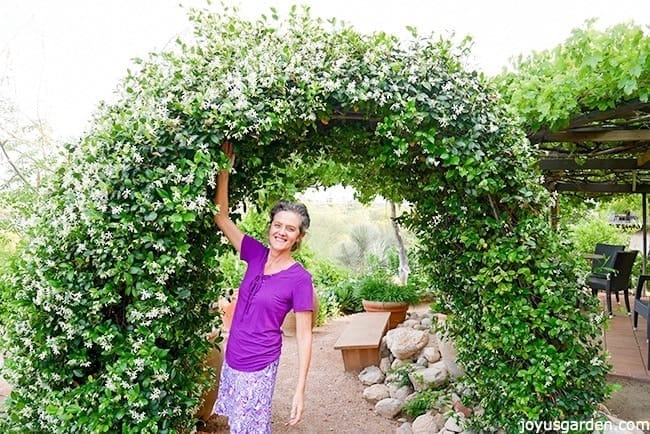
It’s an excellent choice to use as an evergreen vine. It can be trained to grow on a trellis, over an arbor, as an espalier against a wall or fence, as a border plant or hedge, as a groundcover, and to spill over a wall. It can also be grown as a container plant.
Star Jasmine Traits
Size
A Star Jasmine plant can reach 25′ tall. It needs support to reach that height. Otherwise, it just flops back on itself. It’s a twining vine, so you’ll need to train and attach it right from the start.
As it grows, it’ll attach to whatever structure on its own and need little guidance from you. It’s a great plant to grow on a chain link fence because it gives it something to grab onto and twine through without much training.
As a ground cover, it can be kept to 2-3′ as the tendrils will grow more along the ground rather than upwards. I’ve also seen it growing as a trimmed hedge, but keeping it the size you want takes regular pruning.
Growth Rate
How fast does Star Jasmine grow? If getting enough sun and water, then it’s fast growing.
I would prune mine shortly after flowering and then lightly in early fall. By the next spring, it would have climbed back up to the top of the wall again.
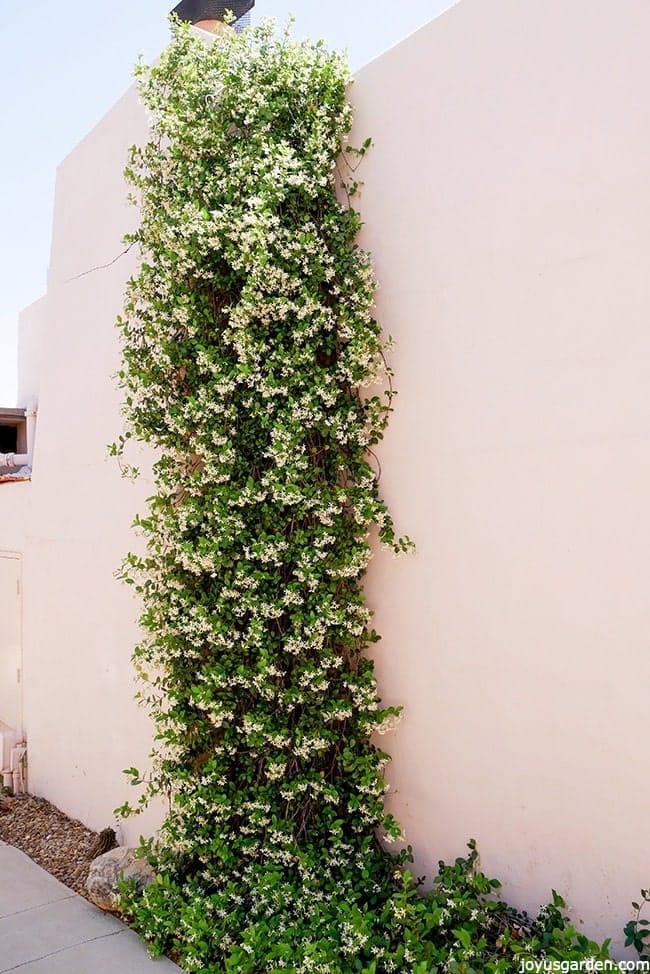
Hardiness
- Star Jasmine Plants are hardy in USDA zones 8 -11. They can take temperatures down to 10-15 degrees Fahrenheit.
- This plant adapts well to both heat and cold, but it won’t survive climates with harsh winters. Enter your zip code here to determine if it’ll grow where you live.
- Star Jasmine “Madison” is a slightly more cold-tolerant variety and is hardy in zones 7-10.
Star Jasmine Video Guide
Star Jasmine Care & Growing Tips
Sunlight
Star Jasmine takes the full sun on the coast of southern California (like Santa Barbara, where I used to live), or further up in the San Francisco Bay Area right through to Seattle.
In Arizona or other places with hot summers, it must be protected from full sun and does best in partial or bright shade.
Mine gets one hour of direct sun in the morning and a little late afternoon, but it’s bright all day. The more sun it gets, the more water it needs to keep it looking tip-top.
Watering
Star Jasmine does best with regular water, and how often depends on your climate. Here in the desert, I water my established Star Jasmine (which is on a drip) twice a week in the hotter months.
If you have new plants, it’s a good idea to water them every other day (especially for the first growing season) until they get established.
Depending on your temperatures and rainfall amounts, regular might mean every 10-21 days. In a nutshell, you want to water when the top few inches of soil are dry.
It’s not a drought-tolerant plant, but it’s not water greedy either. The more sun and heat it gets, the more water it needs.
Star Jasmine is a popular landscape plant. Here we Answer Your Questions About Growing Star Jasmine.
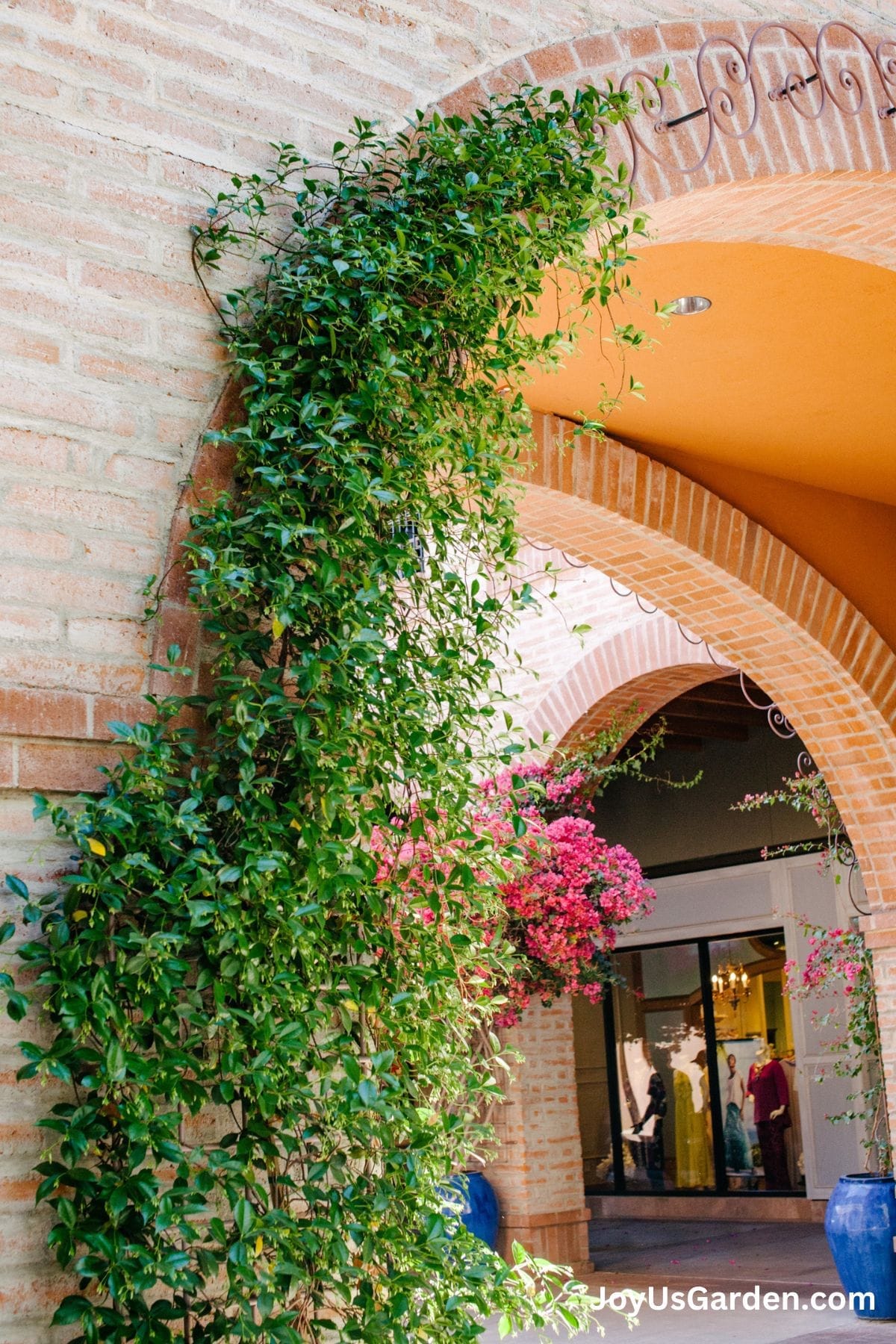
Soil
The Star Jasmine plant is fairly versatile regarding types of soil but prefers loamy, well-drained soils. When planting, I always amended the soil with a proportionate amount of local compost or some other organic material like leaf mold or worm compost.
If planting Star Jasmine in a container, use good quality organic potting soil and mix in some compost or other amendment.
Fertilizing and Feeding
I’m unsure what the best fertilizer for a Star Jasmine plant is. I’ve maintained and planted many Star Jasmines and never fertilized them. They’ve always been very happy with a good dose of organic compost in late winter or early spring (depending on your climate zone) every year or 2.
I put a 4″ layer over the planting surface of mine here in Tucson in late winter, which not only nourishes it but holds in some moisture when the intensely hot and sunny summer rolls around. Composting every other year was fine along the coast in the San Franciso Bay Area, which is much cooler and way less sunny.
If you prefer an alternative feeding method, this all-purpose balanced fertilizer would be fine to apply to the soil after the plant is done flowering.
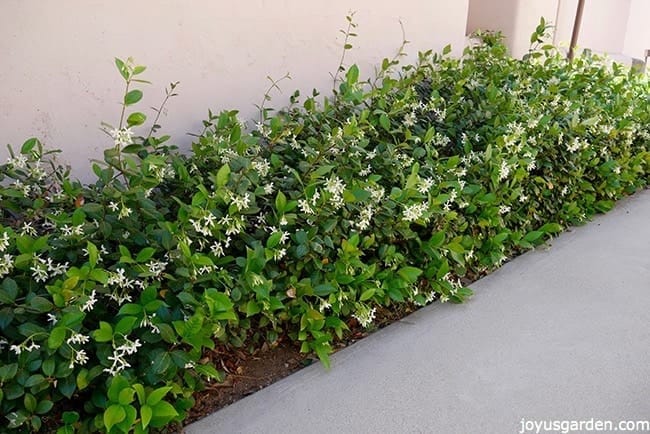
Best Time to Plant
Star Jasmine is best planted in spring or fall (with enough time to settle in before the below-freezing temps hit). The plants have an easier time settling in when the days are warm and the evenings are cool.
You can plant in the summer, but you’ll have to water more as it’s establishing.
This guide on How To Plant Shrubs To Grow Successfully will give you details as to the steps.
Pests
The two pests I’ve seen infest Star Jasmine are mealy bugs and scale. This plant grows densely, so be sure to check the inner foliage and stems every now and then. Treating any pests from the get-go is best so those scale insects don’t spread.
If growing it in the South, I’ve heard that Japanese Beetles can be an issue.
Pruning
Star Jasmine has a somewhat wild growth habit. Those twining stems like to wander! It’s best pruned right after the big seasonal flowering. I won’t go into the specifics of pruning this plant here because I’ve written four posts on this topic already, which you’ll find in the pink box below.
When cut, a cut stem oozes out a milky sap, but it never irritated me. Be careful and protect yourself with gloves and long sleeves because it could irritate you. And you’ll need to clean your garden shears after pruning because they’ll be covered with dried sticky sap.
It can be pruned heavily as a border plant or lightly grown as a tall climbing vine. I prune mine when it’s through flowering and then do a light pruning in November to shape up if needed. I find this plant to be manageable and not too hard to prune.
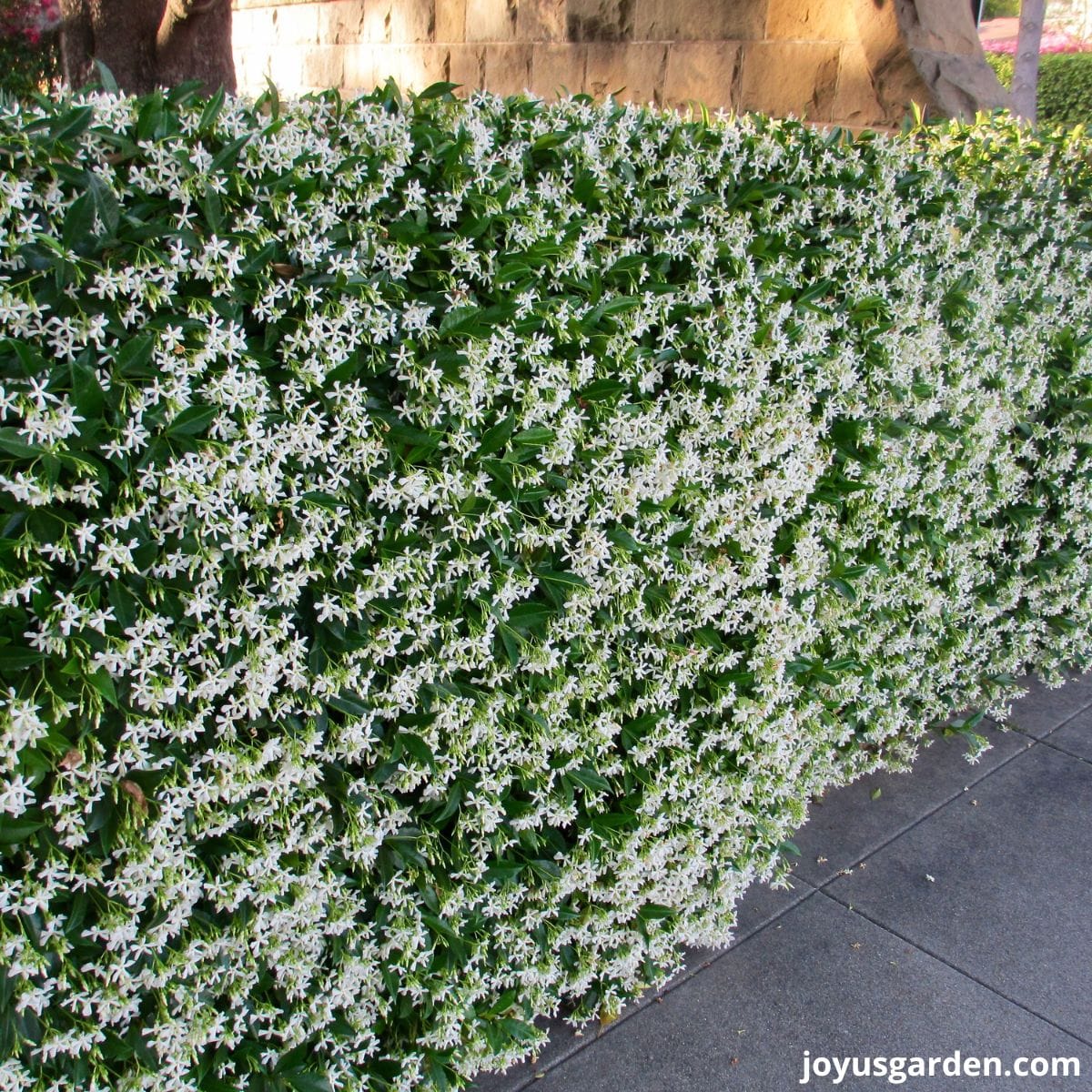
Flowering
Oh yes, it does! A profusion of starry white fragrant flowers covers the plant in late spring or early summer, depending on your climate zone.
The flowers are sweetly scented, though not as strong as Pink Jasmine. The flowering process lasts for a couple of months.
You might get a bit of intermittent flowering in summer into early fall, but the big show comes earlier in the season.
When the glossy light green new growth appears, and the plant is covered in blooms, it’s a beautiful sight to see!
How to Grow Star Jasmine
In Pots
Star Jasmine does fine in pots. What size pot you need depends on the grow pot size and whether you’re planting it solo or with other plants.
For instance, if you’re planting a 5-gallon Star Jasmine to grow on a trellis, you’d want a pot no smaller than 22”w by 22” deep.
If you’re planting a 1-gallon Star Jasmine by itself, a 14” x 14” pot to start it off would be fine.
When planting a smaller landscape plant in a bigger pot, I’d fill in with annuals the first season or two so it didn’t look so bare.
Be sure to use good quality potting soil like this one or this one. Add some compost or organic materials for richness and to aid in drainage, and you’ll have a well-suited potting mix.
In terms of watering, be mindful because plants in containers typically need watering more often than those in the ground.
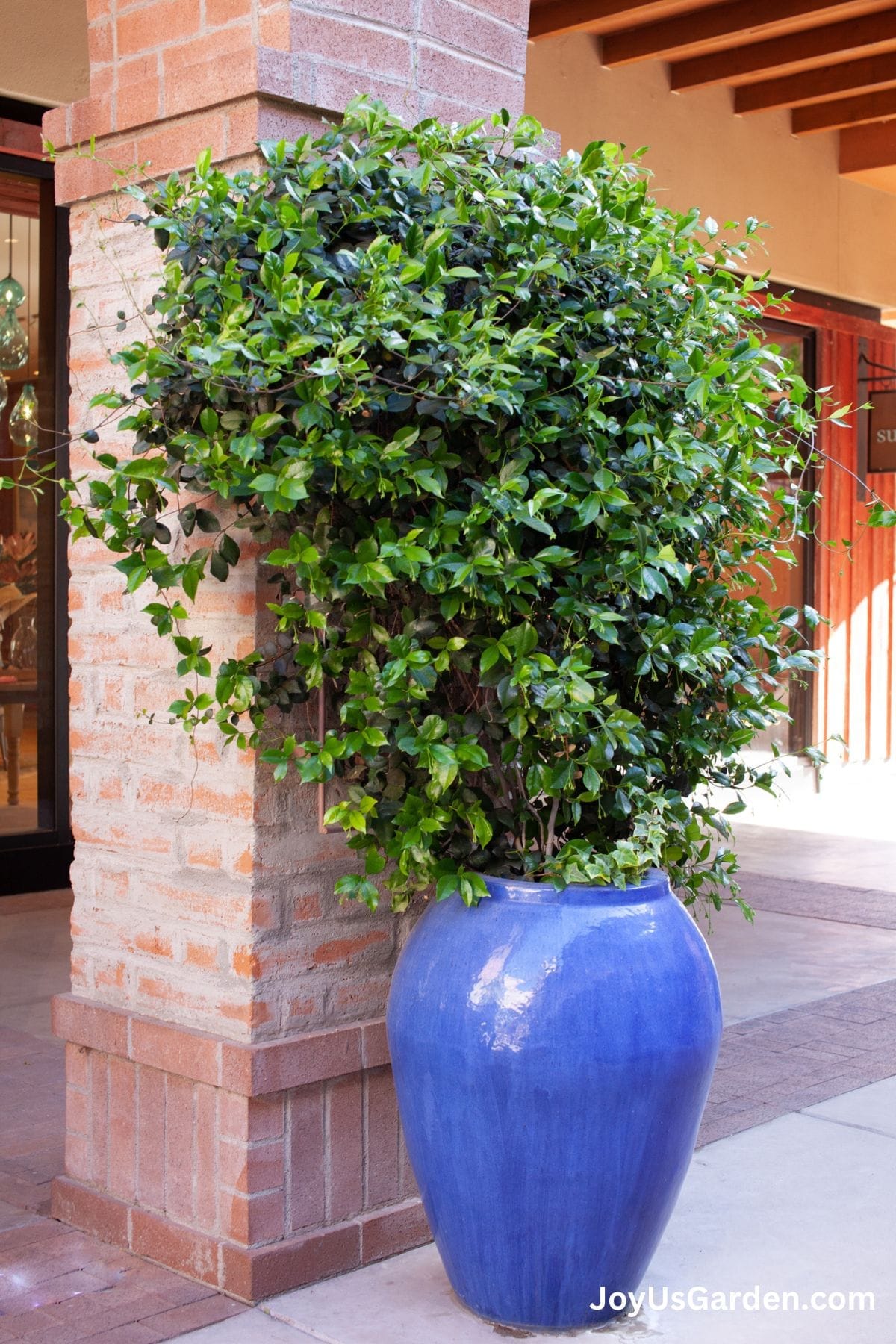
On a Trellis or Arbor
A Star Jasmine plant is great on a trellis or over an arbor. You need to train and guide it in the early stages, but after a while will twine and attach on its own.
If you want to use it as a wall cover, it’ll need a training method like this one or this one and as additional support.
Hedge
Yes, as evidenced by a couple of photos in this post, it’s used as a hedge. In my professional gardening days in the SF Bay Area, one of my clients had a low Star Jasmine hedge lining her long walkway up to the house.
It was somewhat of a pain to maintain as it needed pruning three or four times a year to keep the twining stems in check. They wandered into the walkway and the beds. I think other plants are much better suited maintenance-wise to use as a hedge.
That being said, it’s very pretty and grows fast. If you want to use it, go for it!
Ground Cover
It’s a great ground cover where you want more height and volume than commonly used plants like Creeping thyme, Sedum Angelina, Vinca minor, Ajuga reptans, etc.
It reaches 3′ fairly fast, and if you keep it pruned to 2′, you’ll get more lateral growth.
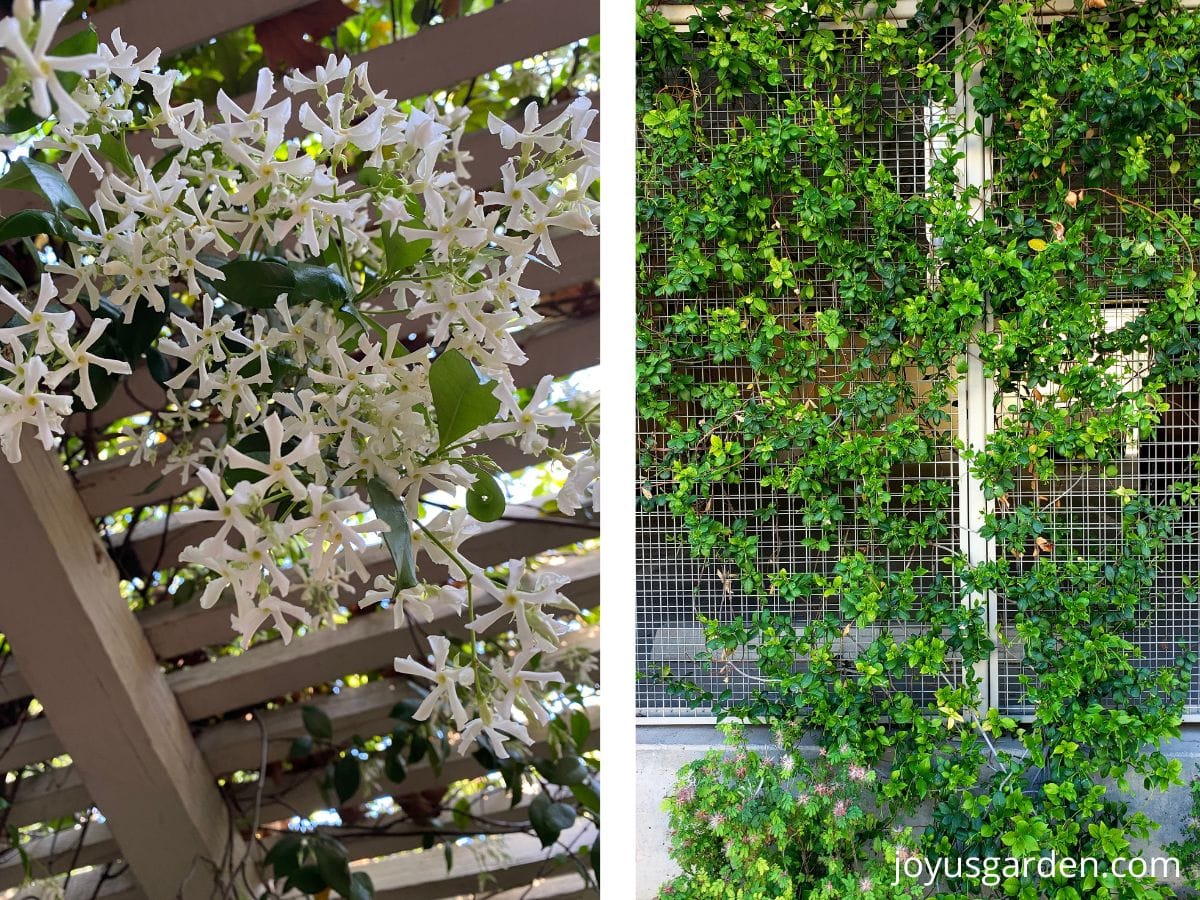
Star Jasmine in Winter
I’ve always grown it in climates with warmer winters – the SF Bay Area, Santa Barbara, and Tucson. I never did anything regarding winter care except composting/mulching every year or two.
If needed, I did a light prune in early fall to shape or tame any crazy tendrils.
Don’t be alarmed if you see some Star Jasmine leaves turning red in fall and winter. The color change is a reaction to the lower temperatures in the colder months. Most of them will drop off in spring as the temperatures warm and the new leaves appear.
Is Star Jasmine Poisonous?
Trachelospermum jasminoides is non-toxic, according to the ASPCA website. It does emit a sap when cut, which has never irritated me. Be careful, though, because it could cause skin irritation for you.
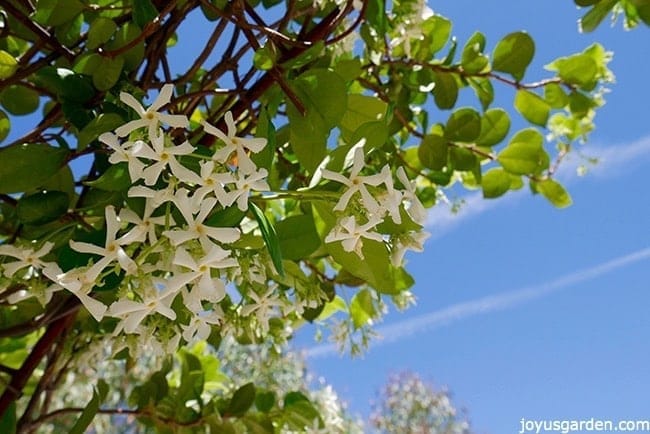
Care Guides On Other Vines: Bougainvillea Care, Pink Jasmine Care, Cup Of Gold Vine Care
Things to Love About Star Jasmine
- It’s versatility. It can be used in so many ways.
- It’s easy to maintain. It’s generally manageable and takes pruning very well.
- The foliage is a beautiful dark glossy green contrasting with lighter green new foliage.
- You can find it in garden centers as well as big-box stores. If you don’t have any close, here’s a Star Jasmine you can order online.
- This plant also comes in a variegated form if you prefer. It’s not as easy to find, though.
- And, of course, the strong fragrance of the starry white flowers.
Star Jasmine care is simple, and those fragrant flowers and glossy dark green foliage make this plant oh-so appealing. Give one a try!
Happy gardening,


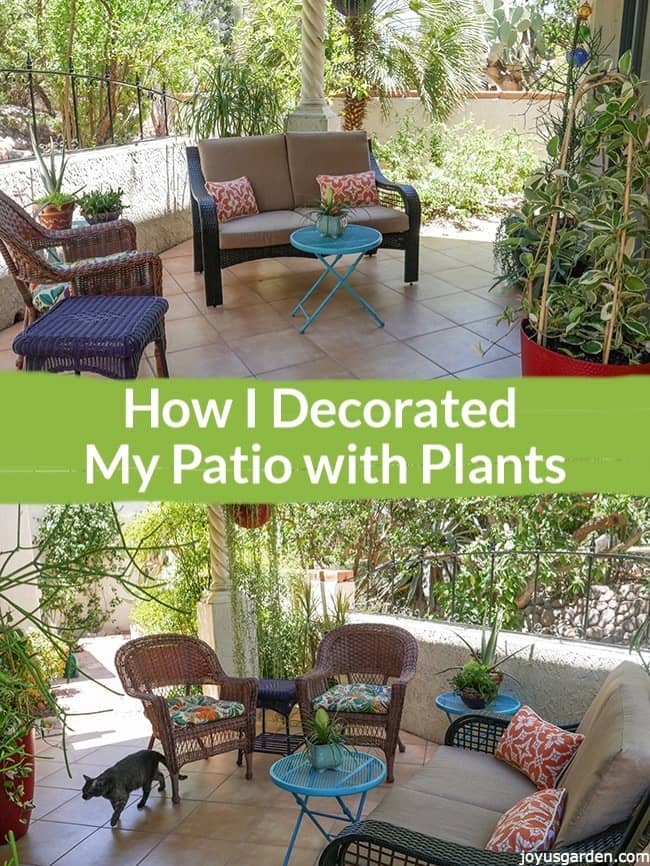
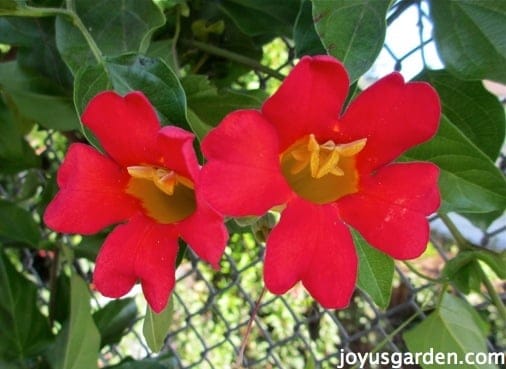
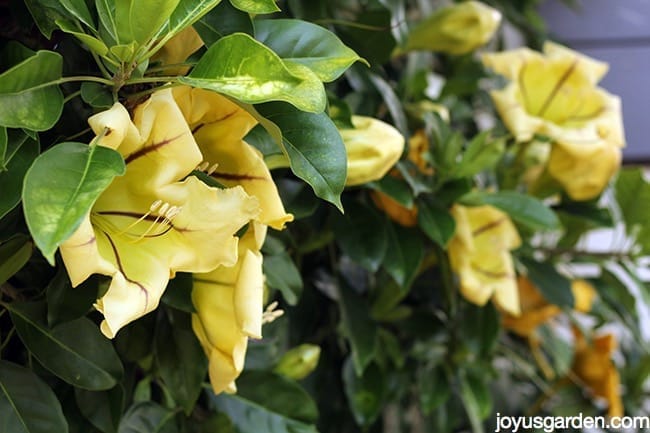
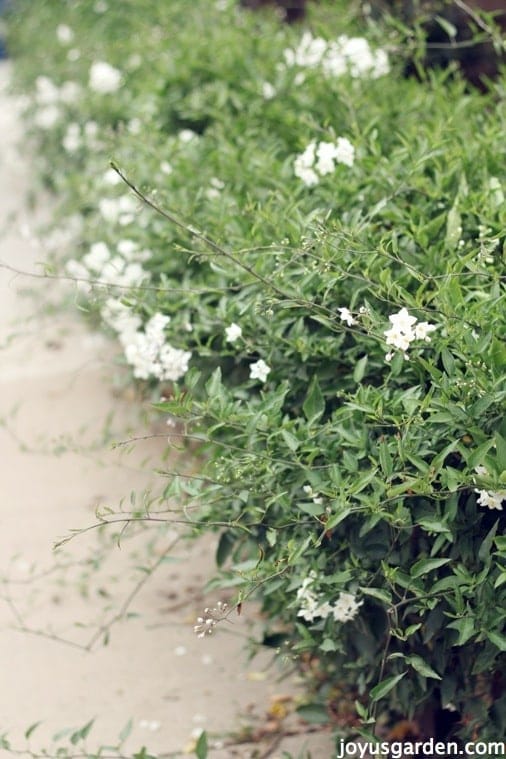

will jasmine grow in a pot… or does it have to be planted in the ground
Hi – Yes, Star Jasmine makes a fine container plant. Just know that as it grows you’ll need to transplant it into a larger pot. Nell
Great video! I love star jasmine and am planting it on a front yard slope this weekend. I am interested in seeing your pruning video if you decide to post one. Thanks!
Thank you! I’ll be pruning my Star Jasmine soon because it has already bloomed. I’ll definitely post the video. Nell
I think you are a great teacher thank you. I have one purchased for a 3 season sun room in NewEngland. ((New Hampshire).
I always wanted a green space indoor as it is cold and dark in New England winters. After experimenting with geraniums, brought in for overwintering, which thrived and bloomed all winter, I thought why not. I lived in Ireland for 2 years and these sun rooms had loads of vines etc.
The room stays at zone 7 or 8 so even if I am away dormancy is no problem nor need to water. Plants make me so happy.
I love green.
Hi Cathleen – Thank you. I love plants & also love sharing what I know. As I say, it’s definitely worth a try. I’ll be in New Hampshire this August visiting family. And yes, I do remember those cold, dark New England winters & that’s when houseplants really add cheer. All the best, Nell
Hi Nell-
Id like to re-direct my jasmine from rambling down a 4′ slope to reverse up into a lovely (dead) maple just behind it.
Its blooming now and I’ve tried to detangle the base branches and prune underneath a bit but, honestly, I’ve no idea what I’m doing. I’m just making maters worse and uglier. I just want to cry when I walk past my little patch of garden.
would you email me?
Please advise.
Hi Lisa – I just pruned my Star Jasmine & right now it doesn’t look fabulous. It needs to grow out & fill in, which it will do over time. Star Jasmine is a twining vine, which can grow up to 20′ tall, but it does need training & attaching to get going. Tip pruning will help it to fill in. And, be patient! Nell
Thank you for doing this video!Could you please tell us what side of the house yours is growing the desert?
Hi Cynthia – You’re welcome! It’s growing against an east facing wall. We had a record heat wave in late June & this plant, along with many others, got sunburned. Temps are back to normal (around 99 – 102) & it’s recovering now. Lots of new growth already showing. Nell
We moved from the central coast (cool) of Oregon to the central coast of Calif. in Feb. We brought our potted jasmine with us. We gave it a nice home, compost sandy soil and Miracle Grow in a large hole. It faces west, against a stucco wall. My husband made an awesome trellis for itand I have “tied” it up to try and train it. Immediately it began to gorw, but seems troubled now. All of this and is refuses to bloom (except a few flowers) and a lot of it’s leaves are turning red, some brown and falling off. The temperatures range in the 60’s and 70′ for the most part. The topsoil seems to dry out in the sun-
Question-what can we do to make this plant happy again>
Hi Carolyn – I lived on the coast of CA for many years; Star Jasmine does great in that climate. The reddish-brown leaves are the older ones which fall off to allow the new ones to grow in. Or, it could be environmental stress, ie: cold, too much water, etc. Star Jasmine blooms heaviest in late spring there so wait until next year. By the way, it blooms on new growth so you want to encourage that with pruning right after it blooms. Nell
hello
ive just bought oe of these climbers but am a bit unsure how to actually plant it. i want it to go against a fence i have but am unsure if i can just plant it upright into the ground near the fence and let it grow or if i lean it towards the fence. also should i leave the supports in that it came with and leave it to grow a bit more untill established before taking them out or do i take them ot stright away and train it along wire that i have put up?
Hi Isabel – I always lean any vine slightly towards the fence, wall or support it’s going on. If the plant has trails long enough to attach to the wire supports, then take the stakes out. If not, wait a little longer until you can. Nell
Hello, I am getting ready to prune my Jasmine. I am wondering if already has grown vines that I need to put on a trellis. this is the first pruning I have done. The vines are sparcely covered with leaves. Should I prune the vines? Thanks for reading my questions.
Flynn
Hi Flynn – I’m about to give my Star Jasmine a light fall pruning too. You want to give it the heaviest pruning after flowering. Give it a tip pruning now. Nell
I am so glad that you posted this video. It hit all the points for someone like me. I have admired this plant for years, but didn’t have the knowledge to take care of it. Thank you so, so much for making this video. The most complete and invaluable information for newbies.
Artesia – You’re very welcome! I try to explain things as clearly & simply as possible so I’m glad you found it useful. I’m doing a post & video soon on the fall pruning (it’ll be a light one) because it needs a bit of shaping after it’s big pruning late this spring. Stay tuned for that. Nell
We are just in early summer here in AUS and my first round of flowers are dying off. Should I remove the browning flowers to encourage a new bloom?
Yes Anthony. The best time to prune a Star Jasmine is after it does it’s big flowering in late spring/early summer. I gave mine anothr pruning in early fall; a much lighter one. Nell
Hi Nell,
I am planning on planting this lil climber to cover only a certain area. It’s a gap in between two Yuccas..the gap is say about 6 ft in height and 2 feet in width. I am planning on getting a fantail lattice or a rectangular lattice. My question is will this plant get out of control? and diff to manage in such small space or will it behave if we prune it. Also will that be a lot of pruning or will the plant adapt?
Also I am planning on planting it in peak summers in Australia, hoping it wont be too bad if i water it enough. Have a shaded spot.
Thanks this is treasure btw!
Cheers
Hi Divya – Star Jasmine can reach 18′ tall but it can also be used as a ground cover – a versatile plant indeed! So yes, you can keep it at 6′ x 2′ but it’ll take some pruning on your part; maybe 2 or 3 times a year. If you train it right from the get go, it won’t be bad to keep under control at all. Here are 2 posts I did on pruning mine: https://www.joyusgarden.com/pruning-a-star-jasmine/ & https://www.joyusgarden.com/shaping-my-star-jasmine-vine/. If your spot is shaded, planting it in summer should be fine. Just make sure it gets nice, deep waterings to establish. Nell
Nell, I wanted to ask about growing as a groundcover. I am in NC and will be using the ‘Madison’ variety of Confederate Jasmine which is just a bit more cold hardy and compact. What’s the best way to train it growing horizontally? Keep pinching back longer shoots? Also, I’m curious about spacing the plants. Any tips would be appreciated!
Hi Jennifer – It only grows about 1′ tall or so. You can pinch it back to keep it low. You want to stagger the planting holes & space them about 5′ apart. It grows fast! Nell
Hello, I also live in Central California and bought a large star jasmine (about five feet tall) that sits in a huge pot and grows on a trellis on my porch. It’s only about a month old, but I don’t think it’s doing well. It seems droopy and some of the leaves are yellow. I don’think I have overwatered it. Any clues as to what I am doing wrong? I’ve grown jasmines before without any problems.
Hi Julie – It’s hard to pin point that because I don’t know the exposure or how you’ve been watering it. Here are the most common causes: the soil is too heavy (they like it rich but well drained), too much water, too little water, sun burn, over fertilizing or chlorosis. They do tend to put out yellow leaves in spring (not an abundance) when the new growth starts. Nell
Thanks, Nell! I live in the cool foggy part of California near Carmel. It has been unusually cold this past month, although the plant seems well-protected on the porch and I think it’s getting enough light. I’m thinking it’s on its way to plant heaven, but we’ll see what happens. Since it looks like it’s dying anyway, I figured I’d risk repotting shock and took it out of its old pot. It didn’t seem too wet or dry, although the center core of the dirt around the pot was tightly packed and maybe hadn’t been getting enough water. The funny thing is that the cheap jasmines I’ve gotten over the years at Home Depot have always done well. This little beauty came from a nursery and cost a mint! Sigh…
We purchased two Star Jasmine from a landscape company last summer, They were beautiful. We live in the Dallas Fort Wort part of Texas. We had some cold weather 9below freezing) and the plants died back to the ground. Now there are little leaves growing just above ground level, Will the plants come back normally or are they lost?
Dave
Hi Dave – Star Jasmine is hardy to 15 to 20 degrees. It’s a vigorous grower so if you’re seeing signs of new growth, they should recover fine. Mine was scrawny when I first moved into this house a couple of years ago, but now it’s loaded with fresh growth & flowers. Nell
Hi Nell!!
My Jasmine plant has been flowering for close to a month. I planted it a couple months ago in a big pot w organic soil and drainage. It gets plenty of sunshine and I had been watering it every day. I noticed that some of the stems had been cut at the bottom, so I pruned the, out along with any dead branches, flowers, leaves, about three weeks ago. My question is: I’ve noticed some dead flowers lately, I want to say about 1/3 of the remaining flowers are brown. It’s still blooming and smells amazing, but is it healthy? I have not fertilized it. Thank you!
Hi Keary – It’s hard to tell if the plant is healthy without seeing it. I can tell you that my Star Jasmine started blooming a few weeks ago & now about half of the flowers are brown. They’re at the end of their bloom cycle. Nell
Hi Nell ~ I’m a jasmine and planting newbie, and really got a lot from your video. Thank you. I bought a few 5 gal white star jasmine plants to train along a fence. Getting different information from nursery staff about pot size has left me confused. I bought 15″ wide by 13″ deep roundish pots that fit the scale of my small patio perfectly, and seem to fit the scale of the plant size well. This will give a few more inches of room around the edges of the 5 gal. soil when I repot them. My worry is that they will one day need repotting and will be attached to the fence which would make it quite difficult! Now I’m thinking that I should return those beautiful pots and get the not so pretty 17 X 15″ pots. Do you think that an extra 2 inches would make all that difference in the long run?
Hi Karen – That’s always a dilemma with plants. Especially vines because they tend to grow fast & are attached to a fence, trellis, wall, etc making them difficult to transplant. Star Jasmine, which can grow to 20′, is fine being tight in its pot. That being said, it is a fast grower. It would ultimately be happier in the larger pot, but for at least 5 years or so, it’ll be fine in the smaller pots. Nell
I have had my Star Jasmine for several years–I have never pruned it just let it grow. well this year the leaves are falling off–scared I`m going to lose it–can you tell me whats wrong with it?
Hi – Plants loose leaves for various reasons Nellie. Unless I can see it &/or know what conditions it’s growing under, I can’t. Nell
I have a star jasmine that I planted and trained to grow on my front railing in front of my porch. We took the railing out 2 years ago so the plant has just been sitting on the ground not doing much but not dying. Is there a way to kind of stack it into a hedge or get it grow as ground cover? I can still pull each strand out separately but don’t know what’s to do with it. Any suggestions? I could also show you in pictures if it would help.
Hi Mary – If it hasn’t gotten too leggy, you can prune your Star Jasmine to grow as a low hedge; about 2′ tall. Or, you can try pinning it to the ground & have it grow as a ground cover. Either way, pruning it will cause it to fill in. Nell
We planted a star jasmine last May in a large flower box on our deck with a pergola for support. We live north of the Seattle area in the islands, zone 7. The jasmine did great over the summer, flowered and even endured the snowy winter that we had. But all of it’s leaves are reddish color now. It’s still pretty but not green like when I bought it. And I don’t see any flower budding happening yet.
Not sure what to do now. Thanks for any feedback! And by the way……we moved here from Tucson.
I never had jasmine when I lived there.
Hi Lisa – My Star Jasmine is in a little too much sun here in Tucson & burn quite badly last summer. It came with the house & I expect it’ll do the same this summer. They’re cold hardy to around 10F. When plant foliage changes color, it’s due to environmental stress. Just let it be for now. The best time to prune is after flowering. If your spring has been cool, the flowering will be delayed. You can give it a nice dose of compost to encourage it along. Nell
Is there a reason my question from 5/5/18 still says “your comment is awaiting moderation?” Is there something I need to do?
I probably just answered it Mary. I get many, many comments each week both here & on Youtube. I sometimes get behind on answering depending on what projects I’m working on. Nell
What is the difference in star jasmine and confederate jasmine please?
They are the same plant Linda – Trachelospermum jasminoides. It goes by this name in the western US where I live & I believe it’s more commonly called Confederate Jasmine in the southern US. Nell
Hi. I was wondering if you could help. I’m looking to plant some Star Jasmine in several narrow, rectanglular planters that will be placed along the base of a chain link fence. I’m hoping for the Jasmine to eventually grow up onto and cover the fence which is about 12 ft. high. Do you think planter boxes that are several feet wide and several feet tall, yet only about 8 or 9 inches in depth would allow star Jasmine to grow up the fence that high? I know it might be hard to imagine, but the fence is a barrier fence for our backyard basketball court. The planter boxes would have to be placed along the bottom of the fence on the basketball court itself, but I don’t want big, round planter boxes that would stick out too far onto the basketball court….which is why I’m hoping narrow ones would work.
Thanks for any advice.
Matt
Hi Matt – I’m not quite sure what you mean. I think you’re saying the planters are several feet tall & long but only 8-9″ wide (deep)? Planter boxes are usually measured this way: H x W x D. If they’re several feet long & tall, a narrow width will be fine. Star Jasmine can reach up to 20′ tall so they need room for those roots to grow over time. Nell
Good morning, I am emailing from England I wish to espalier star jasmine to cover 18 foot of fencing what distance apart would you suggest I plant them. These are from cuttings taken 2 years ago
Thank you very much
Hi Sheila – You can plant them anywhere from 2-6′ apart. Basically, it depends on how fast you want them to fill in & how fast that’ll happen in your climate. Because you’re planting from cuttings (depending on their size), I’d go no further than 2-3′ apart. Nell
I live in San Antonro, Bexar County, Texas. I have a Star Jasmine planted in the ground on a fence with trellis attached. I have had it there for over 18 years. It blooms every mid April to mid May. I have never trimmed it. Just cut back what was growing in the way. This winter we had a few freezes close together and it seems a lot of branches/limbs/vines are dead. It has a few leaves on the top of plant but not many. Is this just old age and its dying? Some limbs I cut from original plant are dead.
Hi Barbara –
I know of Star Jasmines in the SF Bay Area which have been planted for over 20 years & they’re doing fine. Even though they’re generally cold tolerant to 20F, prolonged freezes will damage them. Some cultivars are less cold tolerant than others. Nell
Thank you for the article and the related video.
Hopefully, with your advice, I’ll be able to take better care of the jasmine vines on my property.
Hi Debs – You’re welcome! I just pruned my Star Jasmine – post & video on that coming very soon. Nell
Hi Nell, I bought four jasmine plants a month ago, two of them I’m training on a trellis, the other 2 came already vined up with a bamboo stick and some type of green twine. I planted these 2 also. My question is do I remove this green twine that’s wrapped around the bamboo stick to the Jasmine? I understand it’s like this to train it, but when should I remove this green twine? Thank you
Oscar Q
Hi Oscar – You can remove the green twine because the plants need to be released otherwise they will grow too twisted. This is a twining vine which needs a little attachment & training to whatever you’re growing it on. Nell
I have a large arch around our bedroom window. It is about 8′ tall and 8′ wide and about 2-2.5′ deep. We are in the Sierra foothills in Zone 8, I believe, and I already have a large planter box of star jasmine that has done well so I would like to consider using it for the arch. The arch faces west (generally) and gets afternoon sun/heat, but we have lots of trees (tall pines and smaller ornamentals) that create quite a bit of moving shade as the sun travels throughout the day. The result is that the right side of the arch gets significantly more sun than the left. Will a star jasmine plant run up one side, across and down the other side, or would it be better to place a plant on both sides of the arch to get better coverage?
Hi Marilyn – Star Jasmine can reach 25′ tall. 1 plant will be fine. It’ll probably get a little thin at the ends on the shadier side. I find them easy to train. Nell
can the star of jasmine be started from a clipping of an existing plant? and how would you plant the clipping? do you put in water and wait for roots or just put into the soil? thank you
Yes Jeff they can. Take a 4-6″ cutting & root it in propagation mix. After rooted, then you can transplant it into soil. Nell
Hi Nell,
I was wondering can I use Star Jasmine flowers for a tea? Thank you!
Lorencija
Hi Lorencija – I’ve never heard of anyone doing that so sorry, I can’t give you an answer as to yes or no. Nell
Dear Nell,
I was wondering can I make a tea from Star Jasmine? Thank you! Lorencija
Hi Lorencija – I know that Star Jasmine flowers are used for perfume but I’ve never heard of them being used for tea. Nell
Hi
Should I take off the green bean looking things on my Star Jasime or just let them do their thing?
Hi Karen – Those are the seed pods which don’t commonly occur. You can let them do their thing if you’d like because they won’t hurt the plant. They’ll eventually dry. Nell
Hi
How to divide or clone star jasmine wines, I have a big one and I m trying to sow it’s cuttings but no success
Please comment
Thank you
Samia
Hi Samia – I’ve divided them (with a clean sharp tool) but I know tip cuttings (4-6″ long) in mix can be successful. Nell
Does Star Jasmine grow in shade?
Wanda – Depends on the shade. Here in Tucson, it does best in bright shade or early morning sun. Someplace like the CA coast, it needs sun. It won’t do well in deep shade. Nell
We had star (Confederate) jasmine for years in Texas. We now live in the southwestern portion of Arkansas and I planted six vines in spring. They have grown and flowered beautifully for us and are now quite large. However, since our first freeze here, I have noticed the leaves turning brown and dying at least half way down each vine and I fear the vines will soon be entirely “dead”. I planted it for it’s evergreen quality and as a fence cover. IF this is sometimes normal, will they come back in spring, or should I consider not just the leaves but the entire plant dead. What else would cause this?
Hi Lisa – I’ve only grown Star Jasmine in temperate climates. I do know that the leaves turn brown & start dying in response to winter cold damage. The leaves on my Star Jasmine turned brown when damaged by the hot Tucson sun. Nell
I’m very familiar and fond of star jasmine. It devoured a privacy fence in my backyard. Living in South Florida and thinking to have the star jasmine… indoors…and in a hanging basket. Is this feasible?
You said yes to containers, so I’m hoping a hanging basket is okay, too.
Thank you very much!
Hi – They do fine in containers. I’ve never grown 1 in a hanging basket but I have seen a few growing that way. It’s worth a try! Nell
Hi Nell! Love your bougainvillea and jasmine videos (and posts). They’ve been so helpful to a beginner gardener like my self. My question for you is whether I can pot two small jasmine plants in the same planter? Or do you recommend I keep them separate? Thanks
Hi Deniz – Star Jasmines are sometimes used in bonsai. If a plant is bonsaied, then it can do well in a smaller pot with proper care. Depending on the size of the pot & the plants, they should be fine for the time being. Nell
Hi. I recently planted star jasmine in a large planter that I would like to train up my supporting lattice for a privacy screen. The plants are 5gal in size and currently supported by a bamboo wigwam. Should I remove the wigwam and start training the vines immediately? I planted them about 3 days ago. Thanks! Mike
Mike – If the stems or branches of a plant are long enough to train, I do it right after planting. Nell
Hi Nell!
I’d like to construct a long garden tunnel archway (around 7′ tall and 15-16′ long) and use Star Jasmine to climb up and over it. My local nursery has some in 7″ pots (and a few bigger pots; didn’t see what size). Based on it’s growing habits, how many should I purchase and how far apart should I plant them in the ground? Thanks for your help! -Molly
Hi Molly – It depends on the size you buy & how fast you want them to cover the arch. If you can wait for a few years, every 5′ is fine. Nell
Hi Nell!
I have star jasmine in containers on my back porch hoping they will grow along the railing and provide privacy. The vines are growing and twining like crazy but don’t have many leaves on them-almost none. What could be the cause of that. Thanks!!
McNeill
Hi McNeill – A few common causes which could cause Star Jasmine leaves to drop: not enough water, too much water, or not enough sunlight. nell
Hello:
Best video ever! How do I best train freshly planted Star Jasmine in containers with trellis? Do I run branch/s horizontal? Or do I let them go vertical? Should I train with twine? Or simply twist them around the trellis by hand?
Also, I saw a post where you said if they are young plants, plant annuals to fill in. What is compatible with Star Jasmine?
Thank you!
Hi Nell.
Thanks for the wonderful post. I have two small bushes of pinwheel jasmine adjacent to each other in the ground of my garden. They get identical amounts of water, sunlight and fertiliser. Yet, one is growing fine and flowering okay, but the other is not producing any flowers and is wilting away. Could you please tell me what could be the reason and what I can do to save her? Thanks in advance